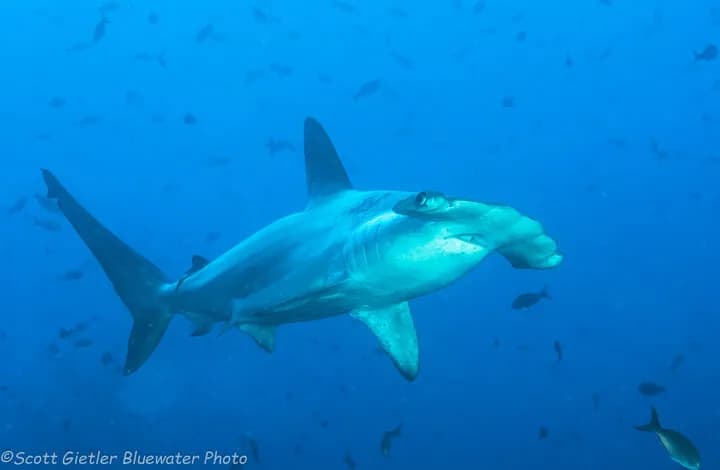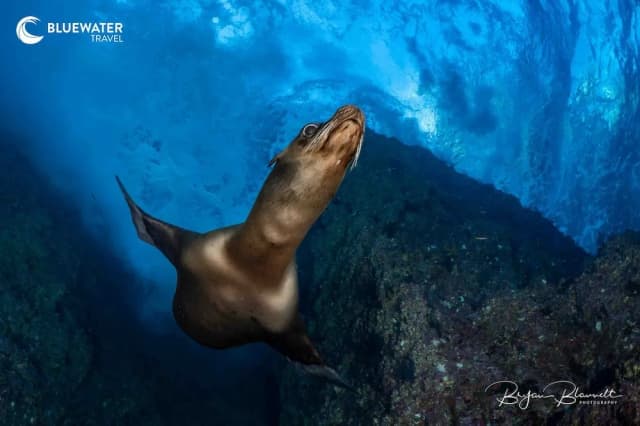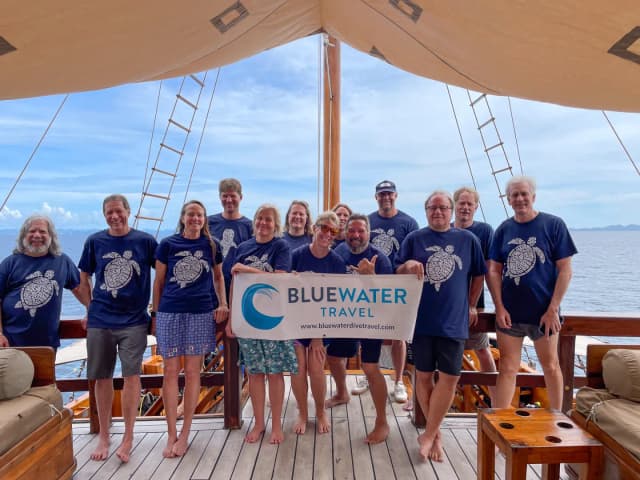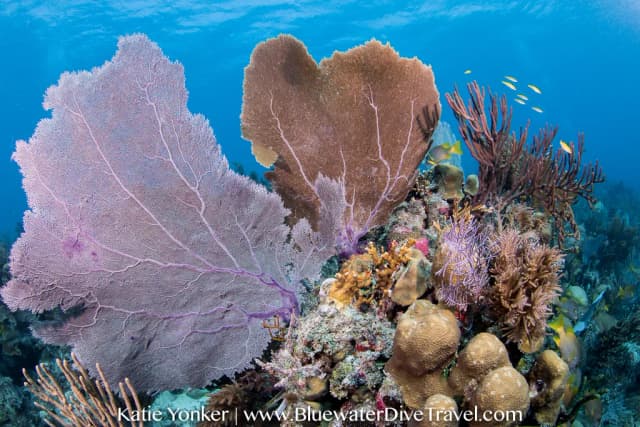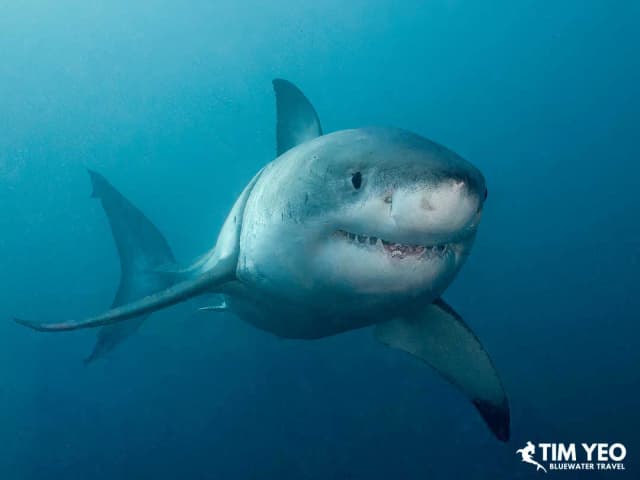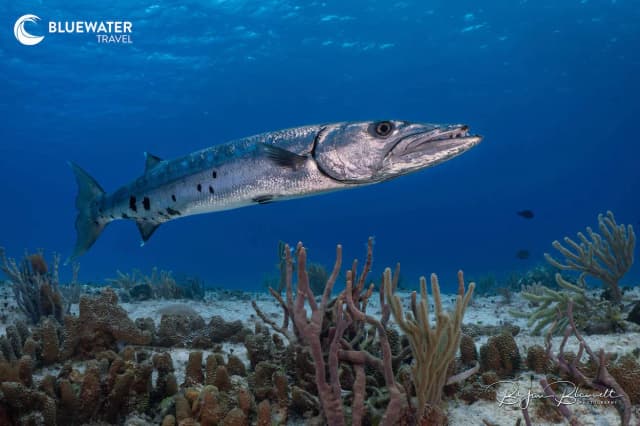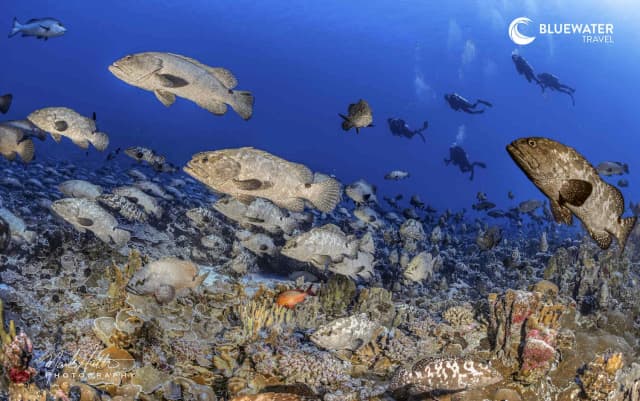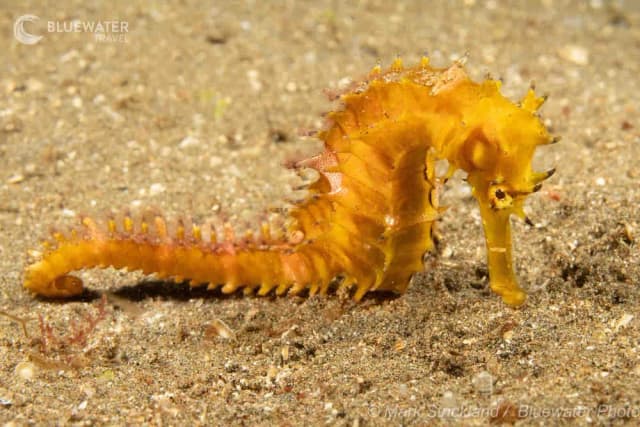Galapagos Islands 2017 Trip Report
By Scott Gietler, photos by Scott Gietler, Josh Comay, Bryan Chu, Ken Leonard, Dan Kurz, Marissa Woodburn
Pre-Journey Prep & Travel
While getting ready for my third visit to the Galapagos, I was brimming with excitement. What new adventures and animals would await me? I started to pack the essentials: 5mm wetsuit, hooded vest, extra sets of gloves, snorkel, super telephoto lens, laptop, and a good sci-fi book. There are several ways to get from Los Angeles to the Galapagos. I could transfer through El Salvador, Mexico City, or Miami, and land in either Guayaquil (GYE) or Quito before taking the final short flight to San Cristobal Island. Last time I opted for Miami to GYE, this time I went through Mexico City to Quito. Lucky for me, AeroMexico allowed me to upgrade to 1st class for the 1st leg of the trip for only $150 at the gate - bargain!
Boarding The Boat
After two 4.5 hour flights, and an additional 2 hour flight, I finally arrived on San Cristobal Island with several of the guests. The guides of the Galapagos Master / Deep Blue were waiting for us at the airport with huge smiles, and helped us wisk our bags into the waiting vans. Many of the guests had landed in San Cristobal the night before, with a couple of them staying in the luxurious Golden Bay hotel. The Bluewater Travel Team are always happy to help book guests on pre and post trip hotels, side trips, or additional land/underwater trips. 10 minutes after being picked up at the airport, we were at the boat having a welcome drink, and checking into our nicely apportioned cabins. The cabins on the boat are nicely sized, and a little larger than most other liveaboards, yet not so big that the boat had to sacrifice space elsewhere in its layout. Our first meal was excellent, a harbinger of many excellent meals over the course of the trip.
Warm-up Dives
Although the warm-up dive on the arrival day was not exciting, we hit the first "real" dive running, and the Galapagos was "on". Hammerheads, mobulas, marbled rays, turtles, stingrays, and other sharks were all sighted in fairly clear, 79 degree water. We were stoked, it was a great start to the trip. The land tour later that day (the first of 3 included land / panga tours) was equally exciting, with plenty of blue-footed boobies, iguanas and displaying frigatebirds sighted at close range. Some of the blue-footed boobies had eggs, but none of them had hatched yet. The frigate birds were out in force, the males all with their distinctive inflated red throat-pouch on display.


After our check-out dive in the harbor


Hungry Chick - photo by Dan Kurz


Mating display of the male frigatebird (iPhone 6s photo)
Wolf & Darwin
We made the long motor to Wolf and Darwin, and enjoyed 4 days with Hammerheads, Galapagos sharks, turtles, eagle rays, marbled rays, whitetips, a Tiger shark, and yellowfin tuna. Darwin is the most exposed island that we visted on the trip, and the panga rides were definitely the bumpiest. Darwin had many turtles, a huge school of jacks, and groups of hammerheads patrolling the sandy areas. The tiger shark we saw at Wolf was a fantastic surprise that several of us were lucky enough to experience. Dives were generally at 50 - 70ft, although some of us had to go down to 95ft to get closer to the sharks. The water was warm, visibility quite good, but currents were strong and the sharks stayed deeper, within sight but often just shy of camera range. We also enjoyed snorkeling with dolphins, and exploring a secret cave at Wolf Island.


Eagle Ray being followed by Scott Gietler


"Goalposts" - Scott Gietler has a turtle with entourage approach him


Free-diving with dolphins at Darwin


It wasn't easy, but several of us did manage to get a hammerhead shot at both Wolf & Darwin. I spent time working with the guests on settings, breathing, strobe position, and positioning underwater - athough it was frustrating because the sharks did not make as many close passes as they did on the previous two trips.
One humorous story from the trip concerned a guest whom I was escorting on the dive to put him in the perfect "hammerhead" spot. Sure enough, a hammerhead went right over his head, but he was looking at his camera. He later said he was playing Tetris, instead of looking for sharks, and sure enough the boat was filled with Tetris jokes for the next couple of days. We even instituted a "No Tetris Underwater" rule! It is also worth mentioning, that several of us joined the DPSS (Dome Port Scratch Society) at this location.


Galapagos Shark making its turn in front of me.
Mola Madness
Over at Isabela Island, in the cooler waters we hit the Mola mola jackpot. All of my whispering paid off, and the guests were treated to several cooperative Mola mola on more than one dive. We also saw Galapagos Penguins in the water, and several guests enjoyed very close penguin and Mola mola encounters after jumping off the pangas with snorkel gear. A nice baitball of Salema was also present, and several sea lions made close passes. The water was cold, getting down to the low 60's, but not as cold as previous trips, and the guests who wore 7mm were happy campers. Mola mola were seen both shallow, and deep well past 100ft depth. Myself, being warm-blooded, was fine in my 5mm suit + hooded vest. A late afternoon panga ride brought us and our cameras close to penguins, pelicans, marine iguanas, and blue-footed boobies.
There is one funny story from this day - on our first dive, we were separated into 2 Mola-hunting groups, and I was with the first group. We did find some Molas, and then we left the area, passing the 2nd group. Now the 2nd group all saw me swim by, and they thought they would not see me again. But - unbeknownst to them, I doubled back, and went deeper looking for Mola mola for them. I found two of them, and the group saw me "rise up from the depths" with a huge smile on my face , arms waving, pointing my arm and giving the Mola sign. The group did then see the Mola, to their utter joy, but they were completely flabbergasted regarding where I came from, and we all had a good laugh about it on the boat.
We were so happy with our Mola encounters, that instead of greeting each other with "hello", we said "Hola Mola" to each other all the time, for no apparent reason, for the entire remaining duration of the trip. In fact, if I were to see a guest from the trip today, we would most likely say "Hola Mola" to each other.






Diving With Marine Iguanas
For many of us, the highlight of the trip was 2 dives with the Marine Iguanas. There were Iguanas-o-plenty, all munching on as much algae as they could eat during their 5 minute dives. The iguana dives were shallow, generally at 10 - 20ft depth. We also got to see the red-lipped batfish, the port jackson shark, and a flightless cormorant came within inches of several guests, including myself. Marine Iguanas enter the water once or twice a day to feast on algae, and they prefer very shallow, surgy water. They will swim on the surface, scanning the bottom for the perfect rock to latch on to while they munch. Once they start feeding, they can be approached without them having a fear of humans.


Marine Iguana swimming back to the surface
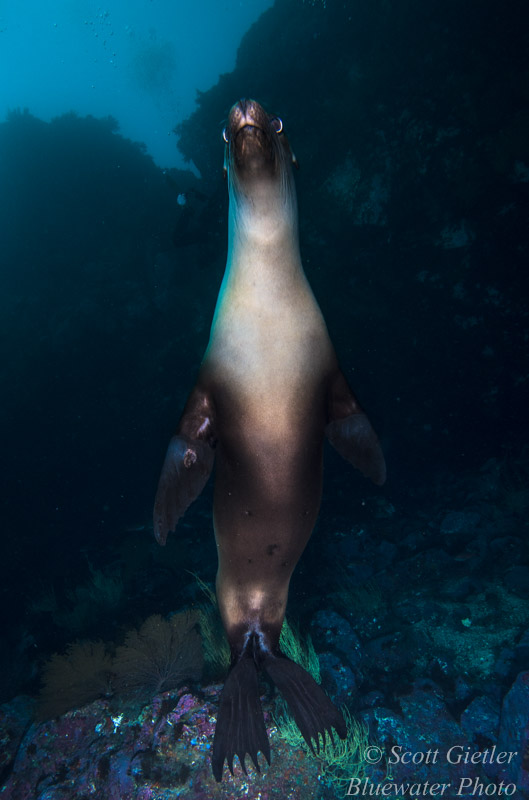

Sea Lion swims away from me
Manta & Mobula Mayhem
Going back to Isabela Island, we encountered several Mantas, a huge school of Mobula rays, stacks of barracuda, a few more hammerheads, and a couple giant yellowfin tuna on our last full day of diving. Seeing a school of hundreds of mobula rays swim by was breathe-taking and a very, very rare treat. I also counted at least 4 times that huge yellowfin tuna larger than myself swam past us, with me barely missing a good shot of them each time. It was nice to be back in warmer water, the surge was gone, the dives were easy, and the animals were big again.


Giant Manta Ray with a posse of cleaner fish


Massive school of Mobula Rays
Galapagos Tortoises
On our last full day in the Galapagos, we dived with white-tip sharks, mobula rays, eagle rays & marbled rays. Five of our guests ended up doing every dive offered on the trip, way to go hard-core diver men and women! In the afternoon, we visited a private farm that had dozens of Galapagos Tortoises on it. They are quite amazing animals, and fun subjects to photograph and spend time with. We spent the evening having dinner on Santa Cruz Island, enjoying the ubiquitous happy hours and doing a little souvenir shopping.
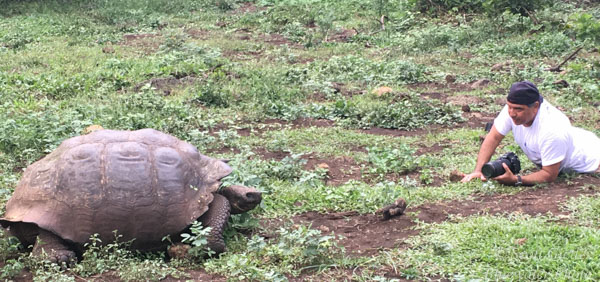

Getting in close with a Galapagos Tortoise (iPhone 6s photo)


Getting down low. iPhone 6s panorama mode
Flying Home
On our last day in the Galapagos, we took the short 90 minute 1PM flight back to Guayaquil. Several of us proceeded to go out for dinner in the town, which is quite close to the airport, as we were then catching the 11PM American flight to Miami, while other guests continued on to Quito. Guayaquil is a busy, low lying tropical city, close to the ocean. It is a hot, humid place, but very convenient because the airport is only a few minutes from the city. Quito is South America's highest capital city, sitting at 9,350ft elevation. From the airport you can see beautiful views of mountains, and trips for bird-watching or to the rain forest are possible from Quito. I tell people for quick transit, go through GYE, and for a 2 or 3 day stay, spend time in Quito.
Compared To My Previous Trips
On my 1st Galapagos trip last year, we had incredible hammerhead encounters, and great luck with Mola mola, but were not lucky with the Marine Iguanas. On trip #2 last year, we again had many close hammerhead encounters, and great marine iguana action, and Orcas - but the Mola mola evaded us. This year, although the hammerheads kept their distance, we hit the Mola / Iguana jackpot - and the tiger shark was a nice surprise. So each trip we've been two out of three, I've been pretty happy with that, as most other people who dive in the Galapagos are lucky to get one out of the three, if that. All 3 trips had excellent topside conditions including lots of sun and fairly calm ocean conditions. I want to give many thanks to the crew of the Galapagos Master for going the extra mile for us, especially when it came to the kitchen, special diet requests, frequent sundeck barbecues, guacamole treats & happy hours, and especially the dive deck operation & dive safety.
Upcoming Adventures (Whales, Sharks, Infinity Pools & More Galapagos)
I hope you can join me on some upcoming adventure. This September, and in September 2017, I'll be leading some special humpback whale intimate encounter trips to Tahiti, contact me for more details and special pricing. This destination is much, much easier to get to than Tonga. In early July, we have 1 cabin left on my French Polynesia master liveaboard trip to Fakarava & Rangiroa, timed for the once a year grouper/shark spawning that is one of the most amazing marine life encounters you will ever have, in warm clear water. Late July / early August I'll be leading a trip to Atmosphere Resort in the Philippines, which is the perfect luxury resort to bring your babies, teenagers, family, friends, non-diving spouse, or photo buddies. This place is true luxury with amazing 5-star staff, fine dining, accommodations, infinity pool, and world-class diving both tiny, and big (coral reefs, whale sharks). Last, but not least, we are going back to the Galapagos in January and May of 2018. Email me or the travel team info@bluewaterdivetravel.com for information on any of these trips.
Gear Used On The Trip
Scott - Nikon D810, Sea & Sea D810 underwater housing, Nikon 16-35mm F4 lens
Dan - Nikon D500, Nauticam D500 underwater housing, Nikon 10-24mm lens
Ken - Nikon D7200, Aquatica D7200 underwater housing, Tokina 10-17mm fisheye lens
Josh - Olympus OM-D E-M1, Nauticam E-M1 underwater housing, Olympus 9-18mm lens
Marissa - Olympus OM-D E-M5 Mark II, Nauticam E-M5 Mark II underwater housing, Panasonic 7-14mm lens
Bryan - Olympus OM-D E-M1, Nauticam E-M1 underwater housing, Panasonic 8mm fisheye lens
Further Reading & Resources
Galapagos Trip #1 Epic Dive Report - Jan 2016
Galapagos Report June 2016 with the Sony A7r II
Orcas! Galapagos Dive Report May 2016
5 Amazing Galapagos Underwater Photo Encounters - from Jan 2016
